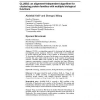1112 search results - page 141 / 223 » Spatio-Temporal Alignment of Sequences |
BMCBI
2008
13 years 9 months ago
2008
Background: Protein remote homology detection and fold recognition are central problems in bioinformatics. Currently, discriminative methods based on support vector machine (SVM) ...
ISMB
1997
13 years 10 months ago
1997
We present a new method for determining the consensus sequence in DNA fragment assemblies. The new method, Trace-Evidence, directly incorporates aligned ABI trace information into...
IJCBDD
2008
13 years 9 months ago
2008
: CLUSS is an algorithm proposed for clustering both alignable and non-alignable protein sequences. However, CLUSS tends to be ineffective on protein datasets that include a large ...
BMCBI
2004
13 years 9 months ago
2004
Background: Hidden Markov Models (HMMs) have proven very useful in computational biology for such applications as sequence pattern matching, gene-finding, and structure prediction...
ISMB
1993
13 years 10 months ago
1993
Using a flexible representation of biological sequences, we have performed a comparative analysis of 1208 known tRNA sequences. We believe we our technique is a more sensitive met...

